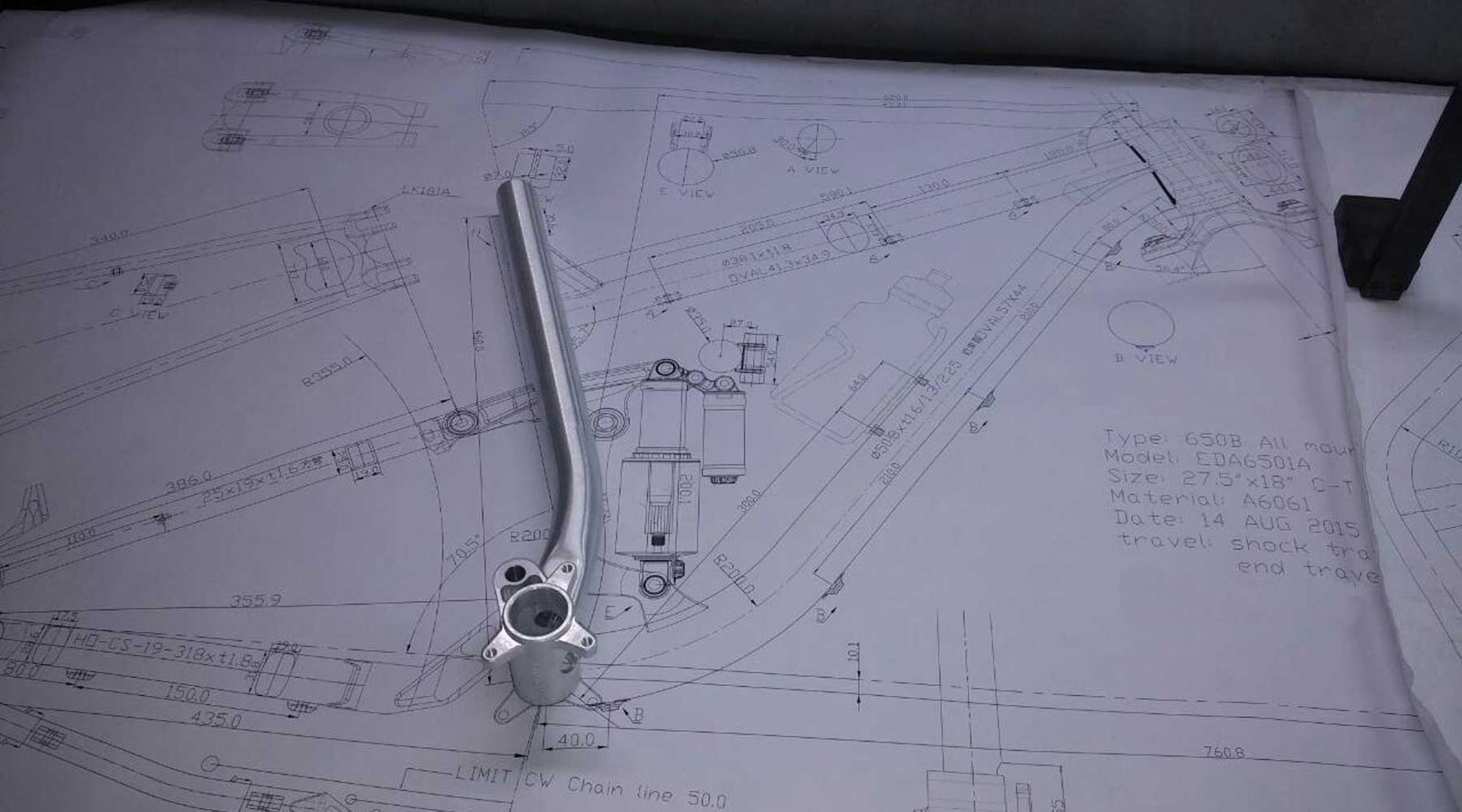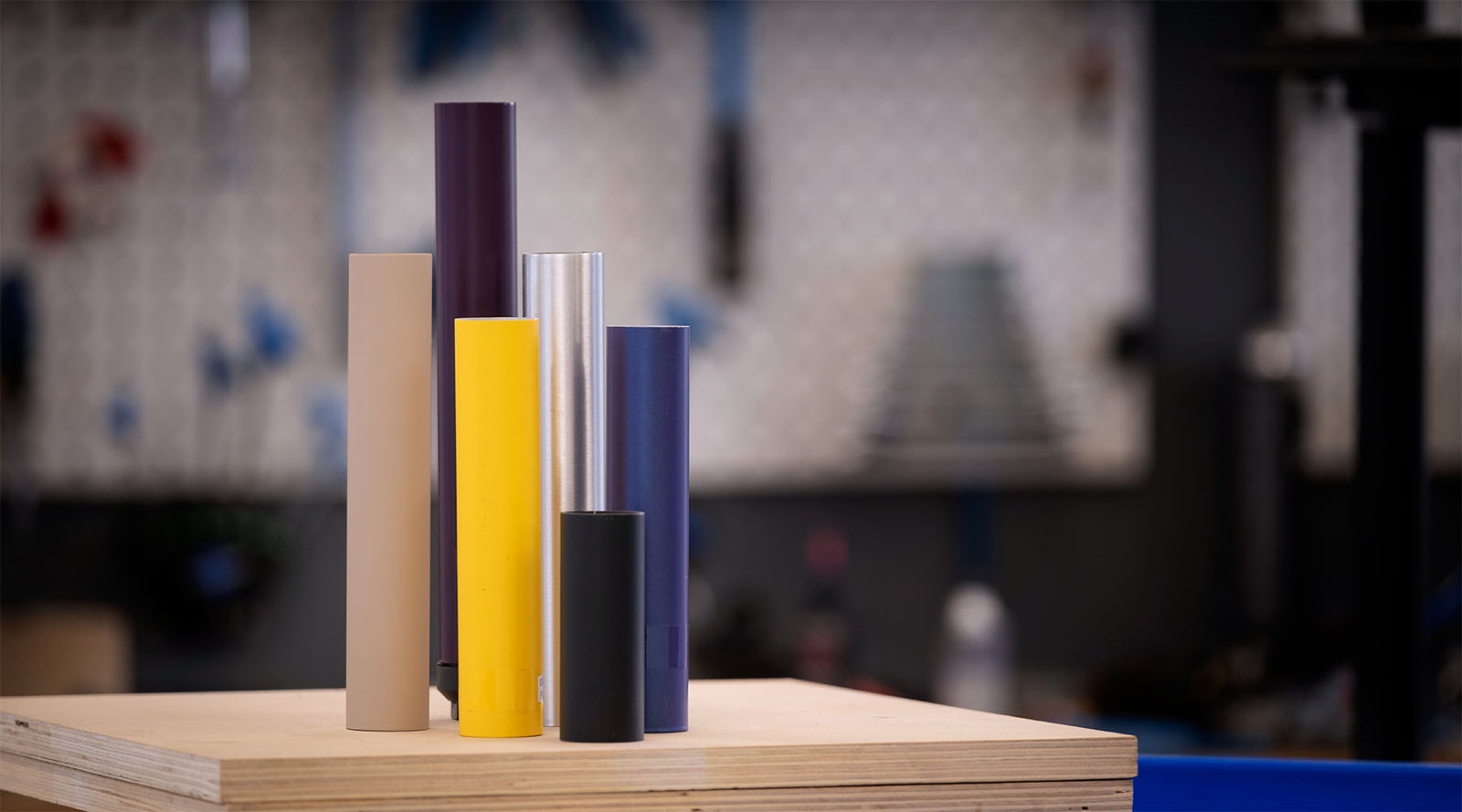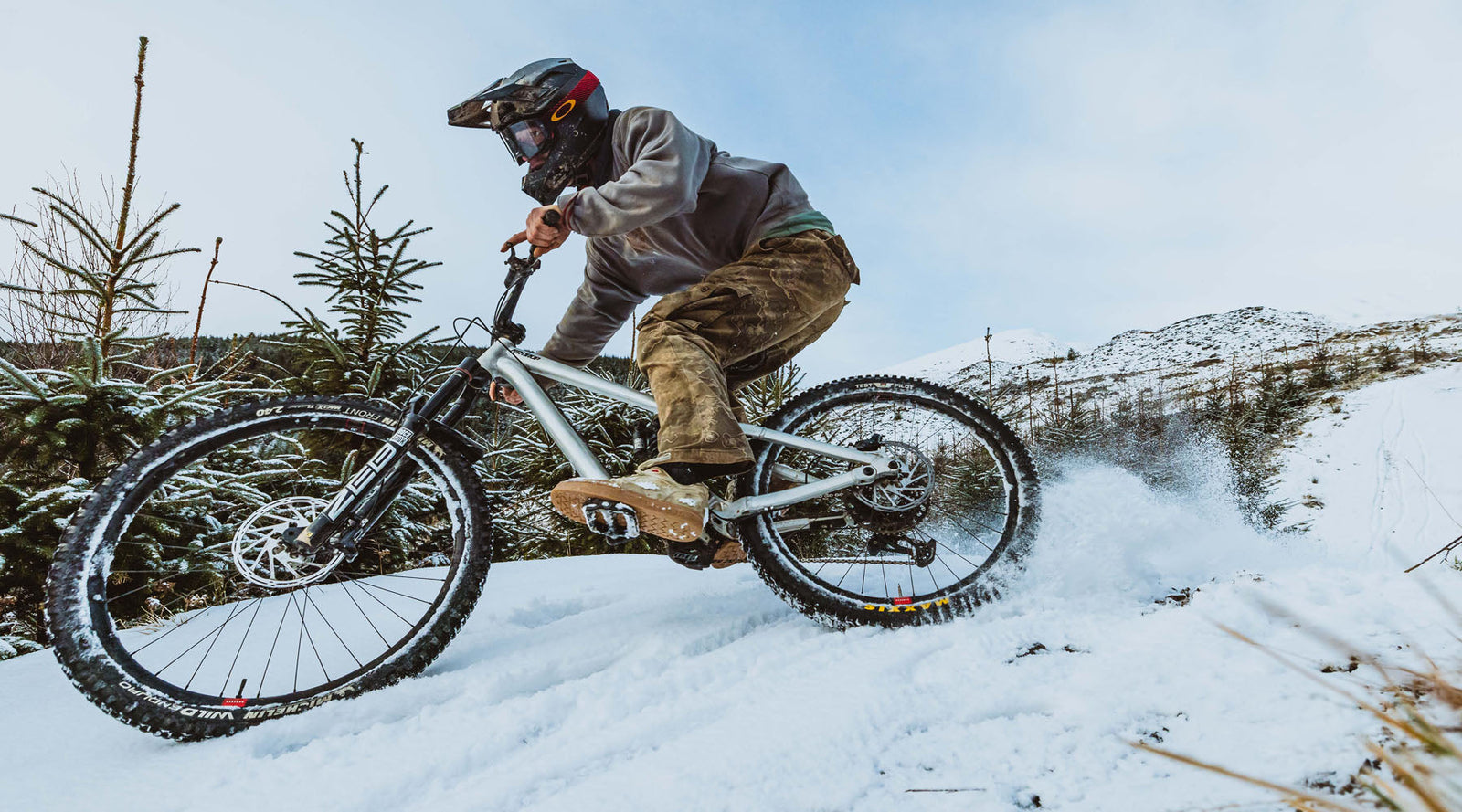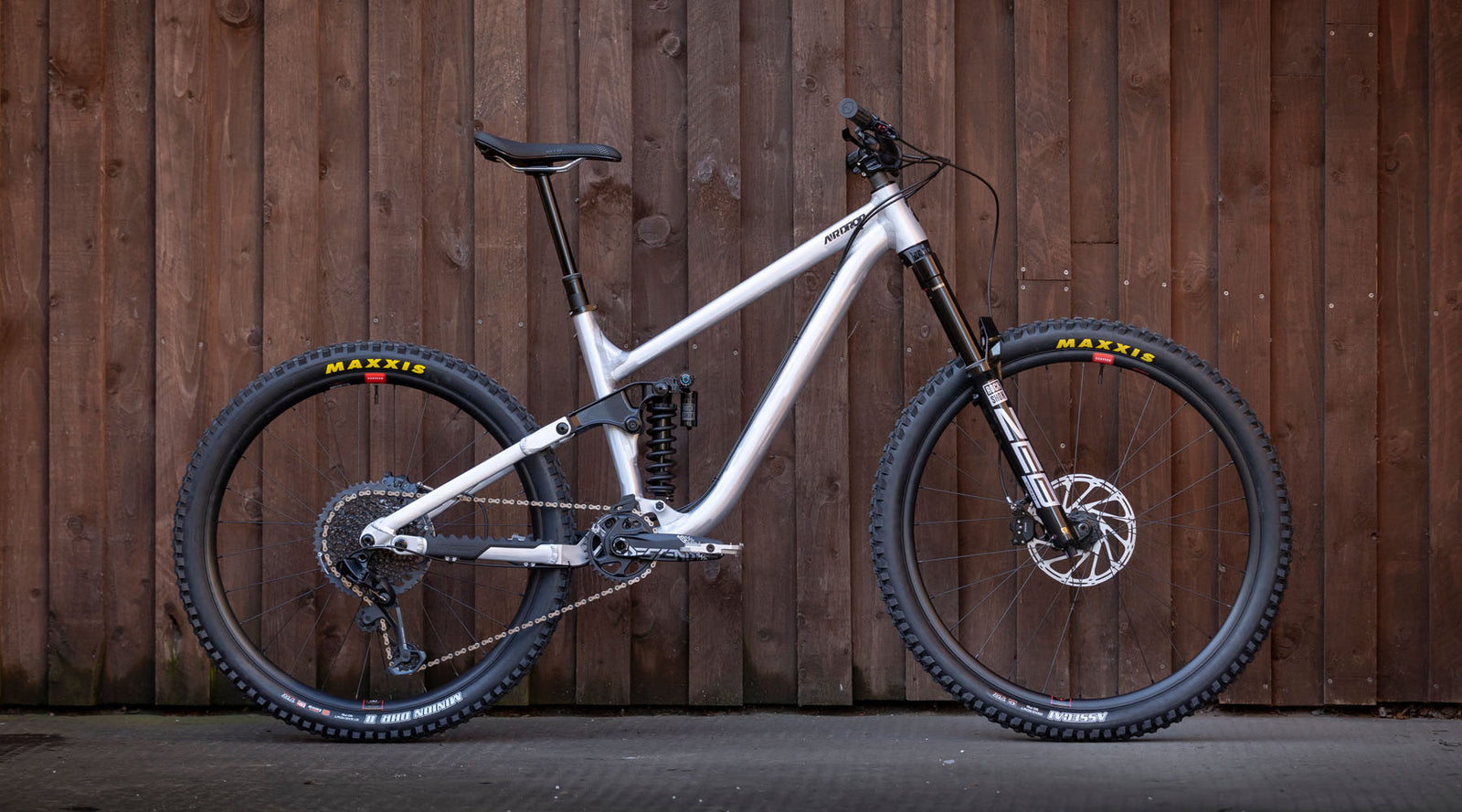
Longer, Lower, Slacker
February 21, 2018
Longer, Lower, Slacker! The current industry buzz words. What I like to call the Kool-Aid. It’s a phrase we hear a lot, whether that’s next year's bike launch, industry moguls preaching radical ideas or media journo’s praising the latest and greatest. For me its starting to wear thin. And I wonder have we gone too far?
In the last 5 years geometry has changed a lot. If we were to take a look at bikes any older than that the norm would be for something pretty reserved with what was ultimately geometry derived from road and XC bikes. But developments in manufacturing, suspension technology and pressure from riders exploring terrain that had long been reserved for DH bikes forced a change. It wasn’t until 2012 when Mondraker launched its forward geometry concept that we saw a big change in production bikes. Forward geometry was the brainchild of Cesar Rojo with input from Fabian Barel - it challenged the norm and was based on a longer front-centre and super short stem. This paved the way for the longer, lower and slacker movement which got us to where we are to day. And that's great, because bikes are much better than they were 5 years ago.

The aim of longer, lower, slacker as a concept was to move away from the lofty, twitchy bikes of the late noughties with their high BB’s, short front-centres and insanely steep head angles. In the beginning the motivation for longer, lower slacker was clear. It was a performance development, and it had to happen, we had reached a limit with dated geometry and the average Joe was riding harder and faster. However it seems to me that in some quarters, longer lower slacker has become a catchphrase for marketing departments and another way to fuel sales. We still have core brands pushing to make bikes faster, and I'd like to think that Airdrop is part of that movement. But as with all successful movements, longer, lower slacker is also starting to be exploited as a marketing tool. It seems to me we're at risk of losing our way.
Reach numbers are fast becoming bragging rights, it's like being back in the playground making claims about the length of your Richard.
I would argue where the industry is right now with geometry is a good place. And if we choose to push the boat out much further we will be making bikes the average Joe will find harder to enjoy. The new wave of extreme geometry - for me at least - is a step too far. To me the essence of MTB is fun and having a bike that allows you to go fast, has stability, inspires confidence but also has a lively, playful ride. A bike which allows you to move around and throw some wild shapes is a bike I want to ride.
Either way it’s a topic that’s starting to create division and you're either a fully signed up Kool Aid drinker, a fence sitter or maybe just confused about all the hoo-ha. But before you reach for that kool refreshing drink of Koolaid ask yourself are you Ron Jeremy? Do you need that super long reach in your life?
Progressive or Extreme Geometry?
A few smaller brands are forging ahead with some pretty radical numbers at the moment. They all have a slightly different stance on what is in essence the same concept. But in order to keep things simple it's worth outlining what I would define as extreme geometry and weigh up simplistically a few of the pros and cons.
Reach (Longer)
The horizontal distance from BB centre to headtube centre, typically measured in mm.
Pros: Although it's hard to isolate the benefit of a longer reach on its own, the main perceived benefit of a longer reach bike would be to centre you in the bike more, and with this extra length it should mean rider has to make less input and fewer adjustments to where their weight is as the bike changes pitch. This would really come into its own on high-speed trails and rougher terrain.
Cons: At lower speeds and in tighter flatter terrain a lengthy bike can become a handful and does require some extra muscle and body English to get where you want it.
What's extreme: To qualify as leaders of this radical geometry movement your reach number for a large frame would be in excess of 510mm and could range up to 555mm.
Chainstay Length (Longer)
Distance from BB centre to rear axle centre more accurately described as rear centre. Typically measured in mm.
Pros: A longer rear centre should result in increased stability in rougher terrain, increased compliance and grip. It may enable the rider to load the rear wheel more aggressively in corners as the wheel is less likely to break traction. By placing the rider's weight further in front of the rear axle you also reduce the likelihood of the front wheel lifting on climbs.
Cons: A long rear centre requires much more effort to lift the front wheel & manual. And can make a bike feel slow and lethargic in tighter terrain.
What's Extreme: Again intended purpose and wheel size can be a factor in chainstay length. However for a typical bike with 27.5 wheels anything north of 445mm would be considered lengthy.
Head-angle (Slacker)
The angle at which the headtube centre-line meets the horizontal plane, measured in degrees.
Pros: A slacker head angle or rather placing the front wheel further ahead of the rider should make the bike feel less nervous and increase stability on faster or steeper terrain. It would reduce the risk of the riders weight being pitched forward on steeper terrain this would normally result in increased confidence.
Cons: At slower speeds or in flatter terrain loading the front wheel can become hard, which can result in a lack of front wheel grip and understeer.
What's Extreme: It very much depends on the purpose of the bike and normally its wheelsize but let's use a modern 160mm 27.5 inch wheeled bike as an example. Anything slacker than 64 degress would probably be considered as radical.
BB Drop (Lower)
BB height in relation to horizontal axle centre. Normally a minus number and typically measured in mm.
Pros: A lower BB resulting in a lower centre of gravity will lead to a more planted and stable feel.
Cons: A lower BB can result in striking pedals on technical climbs.
What's Extreme: Again dependant on wheelsize and frame travel, using a 160mm travel 27.5 inch wheeled bike anything lower than -15mm would be pretty extreme.
The whole package
If we were to bundle all that together we would arrive at something ressembling the current crop of Extremists. A wheelbase in excess of 1330mm, much slackness, a stretched out reach and rear end like something out of a Biggie Smalls video. A bike that some would have you believe is the only way to go: it will excel in rough terrain, will be stable at speed and require less rider input when things get rowdy. And against the clock could be quicker.
So why aren’t we all making bikes like this?
Disclaimer
So before we get started and I receive death threats and hate mail from the Kool-Aid drinkers, I want to be clear that it is not my intent to make this about I'm right & you're wrong. Just to hopefully question the logic and allow the reader to come to their own conclusion of what suits them.
Writing this post has been a tough one, it's been something I've been holding back on for months. Mainly because I know everyone is so invested in what they are doing and by writing this I don’t want it to become a criticism of anyone else's work. The truth is we all have our own opinion and logic and that’s what we are going to stand behind.
Anyhow, disclaimer over.
Weighing In
If we were to backtrack a few years, then I was fully signed up to the movement. Being a taller rider and coming at things from a DH background I was all for it, it made sense. Since a young age I've been fascinated by geometry and how small tweaks make a massive difference to the way a bike rides. As a teen I had clowned around with offset bushes long before they were cool. And whilst working for another company I had the opportunity to cobble some samples together with what at the time was ludicrous geometry. So it's fair to say I've sampled said Kool-aid and now know where I stand.
For me this started out in a previous job, developing a new bike and the first time out riding a sample. We had decided to adopt or at least trial a longer front centre when prototyping. The number we settled on for reach was 460mm. At the time this was long and with exception of Mondraker I'm pretty sure it was longer than any Large production bike out there. Immediately the bike just felt right, kind of a WTF moment... why had I been clowning around with these tiny bikes for years? A light bulb went off. Immediately it was a question of how far we could push it. So off we went incrementally lengthening and slackening each time. But it wasn’t long at all until we arrived at a bike that had sucked all the fun out of the riding I do most. Sure the longest bikes excelled in certain areas; I wasn’t contesting that but the feedback was clear from all parties that the longest bikes felt like a handful in tamer terrain and at slower speeds. Longer, lower, slacker is good, but there is a limit.
For me the current crop of extreme geometry bikes is a step too far.
To me it seems to me that the whole foundation of insanely long reach, silly slack head angles and limousine-like rear ends is based only on what can be measured; seconds. Now from time to time I find myself between the tape but hardly ever - maybe 1% of my ride time is against the clock. The other 99% is in the woods doing daft things with mates and for that reason I put a lot more value on the grin factor not the two tenths I could have gained with a 61 degree head-angle.
Most of my riding nowadays is done locally in Sheffield and despite what many would have you believe, it's not that gnarly. It's pretty tight, we don’t get going that fast and it's not insanely steep so riding one of the current crop of extreme geo bikes would be like piloting an oil tanker down the river Don.
My guess is that most people's riding - in the UK at least - is pretty similar so it makes sense to ride something that we can throw around and have fun with. I'm not saying we should go back to short, steep bikes from years ago, but maybe bikes are long enough and slack enough already.
So rather than jumping on the band wagon I would say it's probably best to consider what suits you best. At what level do your ride? Are seconds precious to you? Do you ride your bike for fun? What do the trails you ride most look like?
The Dream Bike
If I had the opportunity to make that one dream bike, a bike just for me with my own set of ideal numbers what would that look like? Well for me if it had be my one go-to bike, the only bike in the garage, the one I rode for everything it would look a little like this:
The Basics: 27.5 wheels, 150mm out back, 160mm up front.
Reach: At 6ft 2in and with a preference towards 35mm stems that magic number for me would be 475mm. That’s a number I would describe as a good fit for my height. Not so long that I'm going to be straining on slow-speed, tight turns but long enough to keep me in check when things go sideways.
Head-Angle: 65 degrees. Slack enough that I'm not going to be out the front door before I get a chance to do anything about it, but not so slack it's hard to weight the front wheel on flatter terrain.
Chainstay: For me the shorter the better here, love that bass slappin! Sub 430mm for sure. Just makes it super lively, spend as much time as possible on the back wheel. Keep the seat angle steep to prevent the front wheel from lifting but in all honesty I'm well up for a little bit of pain on the ups if it means she's a howl on the downs. I'm well aware a long chainstay climbs better and provides more grip as well as keeping me more centred but I'm not interested. It also makes a bike incredibly boring as far as I'm concerned.
BB Drop: Pretty low at -15mm. Probably the most radical number out of them all. I just like that low BB feeling of being in the bike. This isn’t for everyone and I'm sure a lot of people would worry about pedal strike, but in all honesty I've never been one for technical climbs.
Round up: So there you have it, not earth shattering and nothing too radical. Feel free to disagree! Everyone's entitled to an opinion.
Progression for the sake of it?
As a consumer you are constantly battered with the phrase longer, lower slacker and this is normally portrayed as progressive. But it's almost become the only way for a company to be progressive, or at least it's mandatory for a new bike to be longer, lower and slacker than it's predecessor.
We are all victims of marketing and it comes in many forms, I know I’m a sucker for it. We like to think we are immune to it but ultimately it plays a large role in why we part with our money. And that’s ok! The sooner we accept that the better. We are hit from all angles with marketing. Whether that is the marketing departments at industry giants with glitzy videos and moody photos, athlete's photos in your Insta feed, media journo’s heavily endorsing a product or industry moguls preaching about their ideas... it's everywhere.
Due to this it seems to me it has become engrained in a large perecentage of the MTB community's minds that a bike must sport some ludicrous geometry or it cannot be defined as progressive. In fact a lot are guilty of discounting certain bikes before even swinging a leg over them based solely on numbers (that goes for journalists too).
This has spiralled into a culture where longest, lowest and slackest is best, and therefore created an opportunity for some companies to just make bikes longer to score extra sales. There are few pioneering brands who founded this extreme geometry and others are now pushing things forward for the right reasons. We may not necessarily agree on the numbers but their motivation is good and they're putting in the hard yards. But there are also some who are now just jumping on the bandwagon and their bikes are getting longer, lower and slacker for all the wrong reasons.
To me progressive design is about constant improvement. Improvement is best with regard to bikes when the rider can notice or feel a noticeable performance gain. And I would argue that for further progression we need to look beyond longer, lower, slacker.
Where Does Airdrop Stand?
Me and Ed love to disagree on pretty much everything; that’s the way we like it. We both have very strong opinions and pull in opposite directions a lot. But that’s great and we wouldn’t change it. Ultimately it forces us to challenge and question everything we work on and leads us to better understand and question what’s right and wrong.

At the forefront of every decision is the question, is it better? Our aim is to always question the norm, always be progressive but not just go out on a tangent and be purveyors of the extreme just for the sake of it. Or, for that matter, just to sell a few more bikes. If we don’t believe in it we won't be doing it. We are pretty unique in the way that every bike we make is a bike we want to ride. And a bike we want to ride needs to be fun.
So with regard to geometry, for us just like Wife Swap, compromise is key. Yes we value stability, going fast and grip. But we also accept we aren’t riding the gnarliest, steepest terrain at light speed all the time. And we want our bikes to be easy to ride. Easy to ride means you should feel at home, and if you feel at home you should be able to push that little bit harder, be a bit more creative with your riding and just have fun with it. This means a more balanced position on geometry; longish but not too long, lowish but not too low and slackish but not too slack.
In the end it all boils down to what's best for you, and I'm sure there is a bike out that suits everyone, so buy that bike. But be honest with yourself. What does 90% of your riding look like? how much of a hero are you? Are you going to be racing or just clowning around in the woods?
You can't buy seconds or talent so don’t be a sucker.

James Crossland
James grew up in Sheffield and Wharncliffe is his local. He spent a few years guiding in NZ but now he's back, helping with all things Airdrop.
9 Responses
Bert
October 09, 2018
IMO we’re still in a fun and exciting experimental stage with mtb geometry. We’ve got road bikes (starting point for numbers) and a lack of innovation to thank for the lack of progress in the last 20-odd years. Change has pretty much come all at once and can be a bit over-powering (especially if you’ve recently dropped serious wedge on a bike that the industry is now defining as outdated). It’s an exciting time for mtb’s and we’ve never had more capable machines available. Experimentation should be encouraged (we’ve got 20yrs of it to make up for!)
Gary Winslow
April 05, 2018
Great piece of writing. I have just bought a new bike (not Airdrop – sorry!) and it’s not super slack, long or low. Read some of the magazines, and a brainwashed person might say it’s not ‘on trend’ hence not fun. But it is perfect for my trails (Cannock Chase Trail Centre mainly). Pedally, flowing, not overly gnarly or steep, but challenging in some areas. My ‘middle of the road’ bike does it all, and puts a smile on my face. Your article is spot on. Buy the bike for where/how you ride. Not for the Enduro World Series. And my next bike? Might be an Airdrop!
Simon
February 23, 2018
I don’t think I have read a commentary I could agree more with! I love the P7 I got a couple of years ago, it is similar in many ways to what you describe. I think where I would differ in ideal bike build would be in that most of the UK riding day-to-day 150/160 is a heck of a lot of travel! I could imagine having a whale of a time on 130/140 on all but the bigges Black at fort bill or BPW!
Gavin
February 23, 2018
“Reach: At 6ft 2in and with a preference towards 35mm stems that magic number for me would be 475mm. That’s a number I would describe as a good fit for my height.”
But wouldn’t you have to take into account the effective seat tube angle to get an impression of how the bike would fit?
KoolAiddrinker
February 23, 2018
I think you’ve pretty much nailed it there. Good to see something written from experience too, rather than just surmising.
I’m a Pole rider, so well and truly bought into the long and slack thing. My other bike is a full rigid custom Ti plus tyred bike (also pretty long and slack)
The Pole is great when things are steep and fast, really great. For less gnaaaar riding, it absolutely does suck the fun out a bit. I like to pop off roots and every little lip in the trail on pedally singletrack. The Pole just flattens a lot of that out. That’s when I ride the rigid bike and it’s fantastic for that.
Horses for courses.
Highlights how hard it is to make one bike to do everything! Perish the though…
ThomDawson
February 22, 2018
Almost felt like I was reading something I’d written :P good reading, keep it up
Graham
February 22, 2018
James I agree entirely, I went from an esrly 2000’s intense uzzi which was steep and climbed quite usably, to a yeti 303-RDH and found myself on a LLS bike which was clumsy on the slower local woods trails.. looked unconfident… then would nearly kill you on the fast twisty decents with how it gathered pace!
sq225917
February 21, 2018
It’s like most things, you’ve either got to take the middle ground, or offer two models. I think one of the things that have served Airdrop so well is that you have stuck to the middle way with a sensible geometry and component selection that’s right for the way that the majority of us ride. You could go more XC in one model and more DH in another but then you’d lose the magic in the middle.
Leave a comment
Comments will be approved before showing up.
Also in Airdrop Bikes Blog

New Frame Colours
February 18, 2025
With new batches of Edits and Slackers coming in (Fades just arrived), we've taken the opportunity to freshen things up with new colours.
Read More

Introducing Alf Raynor
February 12, 2025
We're stoked to announce that Alf Raynor is riding for Airdrop Bikes. Alf is likely the hardest man in MTB, he loves the Graft and goes hard on the build. His Raw style on the bike and commitment is something that has to be seen to believed; it's wild.

New Batch of Edits Incoming
February 07, 2025
The new batch of Edit frames is complete and is on it's way to Sheffield. We've taken the opportunity to freshen things up with all-new build options and colours, and preorders are now open.
Email Newsletter
Our monthly email newsletter gets you access to all the good stuff before everyone else.
Get The Inside Line
We're always working on stuff behind the scenes and we'd like to share those stories with you. One email a month, and we make it worth a read.
Sign up to get the inside line.

dave
April 03, 2019
your assessments about what constitutes length in chainstars or reach do not account for rider size. for a 6’ 6" man, a 17 inch chainstay results in a very poor weight distribution and an unstable bicycle. if chainstays scale with rider height on a fairly long bicycle (say 70% of rider height), a medium frame for a 5’ 8" rider guves a 47.6" wheelbase with 17" chainstays. if the bike is scaled for shorter or taller riders at intervals of 4" in height, each frame would need to change by 1" in chainstay length and 2.8" in wheelbase. this would produce frames with the same degree of stability and balance characteristics. An XL frame with 19" chainstays and a 53.2" wheelbase would give a 6’ 4" rider the same balance and stability as the medium for a 5’ 8" rider.